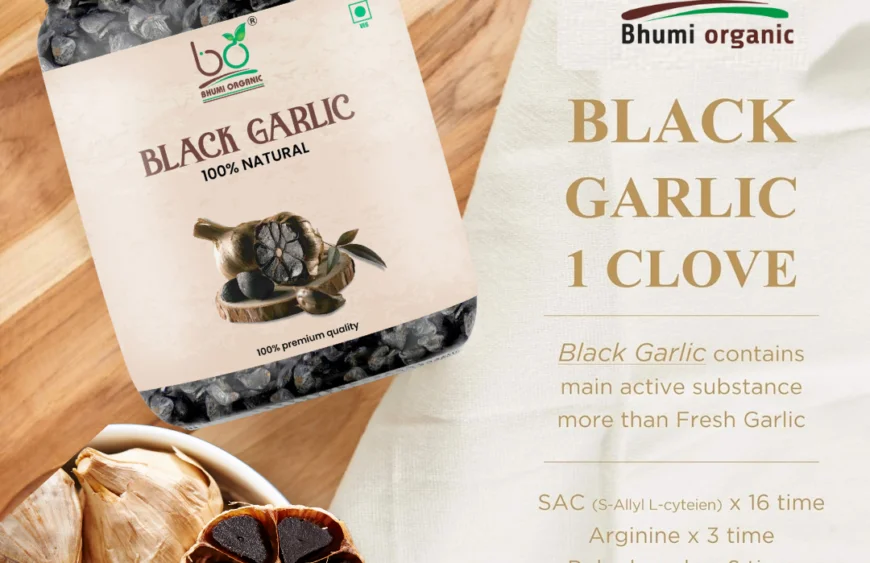Black garlic, with its deep, complex flavors and numerous health benefits, has become a prized ingredient in modern cuisine. Unlike regular garlic, black garlic undergoes a fermentation process that transforms its cloves into soft, black, and sweet-tasting nuggets. This guide explores the origins, production, health benefits, culinary uses, and how to make black garlic at home.
Origins and History of Black Garlic
Black garlic has a rich history rooted in Asian culinary traditions, particularly in Korea, Japan, and Thailand. It has been used for centuries, not only as a flavor enhancer but also for its medicinal properties. In Korea, black garlic is traditionally consumed for its supposed health benefits, including boosting the immune system and promoting longevity. Over the past decade, black garlic has gained popularity in the West, becoming a sought-after ingredient in gourmet kitchens and health food stores.
The Production Process of Black Garlic
Black garlic is made through a controlled fermentation process, which involves aging whole bulbs of garlic at a specific temperature and humidity for several weeks. Here’s a step-by-step overview of the process:
- Selection of Garlic Bulbs: Choose fresh, high-quality garlic bulbs. Uniformity in size and the absence of damage or disease are crucial for consistent results.
- Preparation: Clean the garlic bulbs to remove any dirt but keep the outer skins intact to protect the cloves during fermentation.
- Fermentation: Place the garlic bulbs in a fermentation chamber or a specialized device like a rice cooker or slow cooker. Maintain a consistent temperature between 140°F and 190°F and high humidity (70–90%) for an extended period, typically ranging from two to four weeks.
- Aging: After the initial fermentation period, allow the garlic to age for a few more days to develop its flavors fully.
- Packaging: Once the aging process is complete, black garlic is ready for packaging and distribution.
The transformation of garlic into black garlic is primarily due to the Maillard reaction, a chemical reaction between amino acids and reducing sugars that gives black garlic its characteristic color, flavor, and texture.
Health Benefits of Black Garlic
Black garlic is not only cherished for its unique taste but also for its numerous health benefits. Here are some of the key advantages:
- High in Antioxidants: Black garlic contains higher levels of antioxidants compared to raw garlic. Antioxidants help protect the body from oxidative stress and free radical damage, which are linked to chronic diseases and aging.
- Boosts Immune Function: Compounds in black garlic, such as S-allyl cysteine, enhance the immune system’s function, aiding the body in fighting infections and illnesses.
- Anti-Inflammatory Properties: Black garlic has anti-inflammatory effects that can help reduce inflammation in the body, which is associated with various health issues like heart disease, arthritis, and certain cancers.
- Improves Heart Health: Consuming black garlic may help lower cholesterol levels, reduce blood pressure, and improve overall cardiovascular health by enhancing blood circulation and reducing arterial plaque buildup.
- Supports Liver Health: Studies indicate that black garlic can help protect the liver from damage caused by toxins and oxidative stress, promoting better liver function and detoxification.
- Antibacterial and Antiviral Properties: Black garlic retains the antibacterial and antiviral properties of raw garlic, making it effective in preventing and treating infections.
Culinary Uses of Black Garlic
Black garlic’s sweet, tangy, and umami-rich flavor makes it a versatile ingredient in the kitchen. Here are some ways to incorporate it into your cooking:
- Sauces and Dressings: Blend black garlic into sauces, marinades, and salad dressings to add depth and complexity. It pairs well with soy sauce, olive oil, vinegar, and various herbs and spices.
- Soups and Stews: Add black garlic to soups and stews for a rich, umami flavor. It works particularly well in broth-based soups like ramen or miso soup.
- Spreads and Dips: Mash black garlic and mix it with butter, cream cheese, or hummus to create a delicious spread or dip. It can be spread on bread, crackers, or used as a dip for vegetables.
- Meat and Fish: Use black garlic as a seasoning or marinade for meat and fish dishes. It enhances the flavor of grilled, roasted, or braised meats, as well as seafood like salmon or shrimp.
- Vegetable Dishes: Incorporate black garlic into vegetable dishes, such as roasted vegetables, stir-fries, or salads. Its sweetness complements the natural flavors of the vegetables.
- Pasta and Rice: Stir black garlic into pasta sauces or rice dishes for an added layer of flavor. It works well in both tomato-based and cream-based sauces.
Conclusion
Black garlic is a remarkable ingredient that offers a unique combination of flavor and health benefits. Its rich, umami taste makes it a versatile addition to various dishes, from sauces and soups to meat and vegetable dishes. Additionally, black garlic’s high antioxidant content and numerous health benefits make it a valuable addition to a healthy diet.
Whether you’re a professional chef or a home cook, experimenting with black garlic can elevate your culinary creations. And for those who enjoy DIY projects, making black garlic at home can be a rewarding and satisfying experience. By following the steps outlined in this guide, you can discover the delights of black garlic and enjoy its distinctive flavor and health-promoting properties in your everyday cooking.





